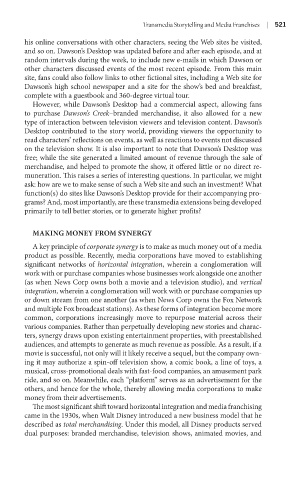Page 542 - Battleground The Media Volume 1 and 2
P. 542
Transmed a Storytell ng and Med a Franch ses | 1
his online conversations with other characters, seeing the Web sites he visited,
and so on. Dawson’s Desktop was updated before and after each episode, and at
random intervals during the week, to include new e-mails in which Dawson or
other characters discussed events of the most recent episode. From this main
site, fans could also follow links to other fictional sites, including a Web site for
Dawson’s high school newspaper and a site for the show’s bed and breakfast,
complete with a guestbook and 360-degree virtual tour.
However, while Dawson’s Desktop had a commercial aspect, allowing fans
to purchase Dawson’s Creek–branded merchandise, it also allowed for a new
type of interaction between television viewers and television content. Dawson’s
Desktop contributed to the story world, providing viewers the opportunity to
read characters’ reflections on events, as well as reactions to events not discussed
on the television show. It is also important to note that Dawson’s Desktop was
free; while the site generated a limited amount of revenue through the sale of
merchandise, and helped to promote the show, it offered little or no direct re-
muneration. This raises a series of interesting questions. In particular, we might
ask: how are we to make sense of such a Web site and such an investment? What
function(s) do sites like Dawson’s Desktop provide for their accompanying pro-
grams? And, most importantly, are these transmedia extensions being developed
primarily to tell better stories, or to generate higher profits?
making monEy From synErgy
A key principle of corporate synergy is to make as much money out of a media
product as possible. Recently, media corporations have moved to establishing
significant networks of horizontal integration, wherein a conglomeration will
work with or purchase companies whose businesses work alongside one another
(as when News Corp owns both a movie and a television studio), and vertical
integration, wherein a conglomeration will work with or purchase companies up
or down stream from one another (as when News Corp owns the Fox Network
and multiple Fox broadcast stations). As these forms of integration become more
common, corporations increasingly move to repurpose material across their
various companies. Rather than perpetually developing new stories and charac-
ters, synergy draws upon existing entertainment properties, with preestablished
audiences, and attempts to generate as much revenue as possible. As a result, if a
movie is successful, not only will it likely receive a sequel, but the company own-
ing it may authorize a spin-off television show, a comic book, a line of toys, a
musical, cross-promotional deals with fast-food companies, an amusement park
ride, and so on. Meanwhile, each “platform” serves as an advertisement for the
others, and hence for the whole, thereby allowing media corporations to make
money from their advertisements.
The most significant shift toward horizontal integration and media franchising
came in the 1930s, when Walt Disney introduced a new business model that he
described as total merchandising. Under this model, all Disney products served
dual purposes: branded merchandise, television shows, animated movies, and

